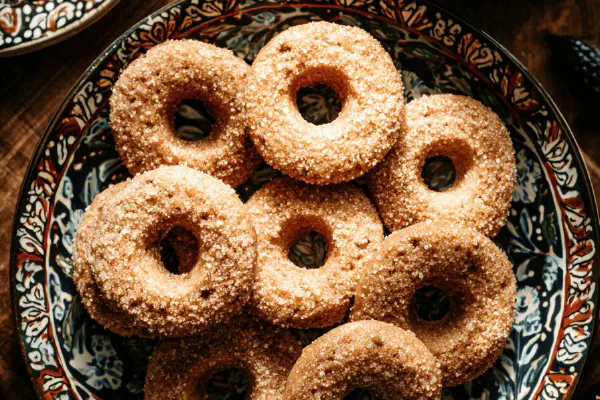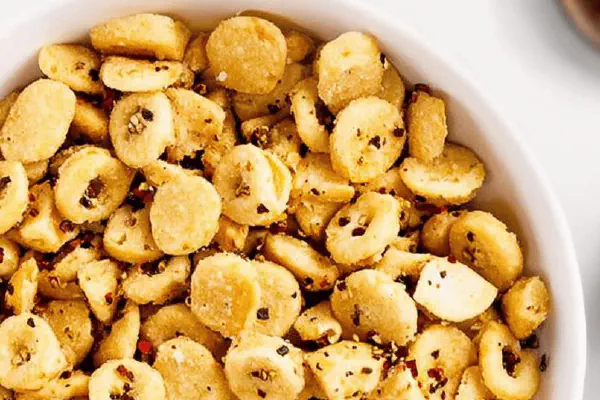Anise-Spiced Italian Rings

By Emma
Certified Culinary Professional
Ingredients
- 105 g (3/4 cup) unbleached all-purpose flour
- 3 ml (3/4 tsp) baking powder
- 60 ml (1/4 cup) dry white wine (or apple cider vinegar diluted with water)
- 90 g (3/8 cup) granulated sugar
- 45 ml (3 tbsp) extra virgin olive oil
- 2 ml (1/2 tsp) orange blossom water
- 2 ml (1/2 tsp) ground cardamom
- zest of 1 small lemon
- extra sugar for coating
About the ingredients
Method
Preheat & prep
- Heat oven to 185 °C (365 °F). Line baking sheet with parchment or silicone mat. Set aside.
Dry & wet blend
- Mix flour and baking powder in a bowl, sift if lumps stick. In separate bowl, stir wine with 75 g sugar until dissolved about 1-2 minutes. Add olive oil, orange blossom water, cardamom, and lemon zest. Stir well to combine — aromatic and bright.
Dough forming
- Pour wet into dry. Use wooden spoon to fold carefully. Dough will be a bit tacky but should gather into a firm ball — avoid overmixing; gluten develops toughness otherwise.
Chill and shape
- Wrap dough tightly; chill 35 minutes minimum. Firmer dough holds shape better, less sticky hands. Split dough into 16 equal chunks. Roll one on smooth surface to ~1 cm diameter, length ~20 cm. Link ends gently, no twisting, form a neat ring with a slight pinch to close.
Sugar coat
- Pour remaining 15 g sugar into shallow dish. Roll each ring to coat fully. The sugar caramelizes, giving crunch and sheen under oven heat.
Baking cues
- Lay rings on tray spaced apart. Bake 13-16 minutes. Watch edges for golden hue; bottoms should firm but not darken deeply. When taps sound hollow and tops spring back to touch, they're done. Let cool on tray; they crisp as they rest.
Storage and serving
- Store airtight once cooled. Keeps crisp days. If softening occurs, refresh in warm oven 2-3 minutes. Pair with espresso or herbal tea for ritual.
Troubleshooting
- If dough too sticky, dust hands lightly with flour, low risk in dough density here. Too crumbly? Add splash more wine or olive oil, little by little. Overbaked yields dry, so lean on visual and tactile clues over timer. Too flat? Ensure baking powder is fresh, do not skip chilling step.
Cooking tips
Chef's notes
- 💡 Separately blend dry ingredients to avoid uneven baking; sift flour with baking powder, no lumps. Wet mix needs gentle stir not whisk for flavor layering; dissolving sugar in wine first helps moisture and sweetness distribute better. Stirring mix brings out scent; cardamom and orange blossom water release fragrance here — smells citrusy but warm. Folding wet into dry gently limits gluten — avoid tough crumb by undermixing. Dough texture sticky but holds together, slight tack is good signal; if too wet add flour cautiously.
- 💡 Chilling dough minimum 35 minutes key; too soft dough spreads or sticks badly during shaping. Wrap tight to prevent drying out. Dough firms for control—roll smoothly on clean surface at uniform thickness about 1 cm, length 20 cm. Joining ends needs light pinch only; tight join risks cracking while baking. Remember dough warmth softens joins fast. Sugar coating last step just before baking; make sure hands dry or sugar melts too quick and gets clumpy. Roll each ring in sugar fully, creates crunchy glaze that darkens in oven. Don’t skip this or surface flattens dull.
- 💡 Baking cues over strict timing; oven spring gives clues. Golden edges and firm bottoms signal close. Tap tests—knock top rings lightly, hollow sound means baked through. Touch bounce back signals interior texture. Oven temps vary; watch carefully past 13 min but under16 is safe window. Smell changes—aroma transitions from citrus spice to toasted sugar; nose works better than clock. Rely on these sensory signals. Cooling in pan important helps rings hold shape rather than racks where drafts cause cracks. They crisp up off heat but stay tender inside.
- 💡 Ingredient swaps practical and tested. Dry white wine swapped with diluted apple cider vinegar keeps acidity & moisture; maintains rise & flavor balance vegan style. Olive oil critical for fat structure; mild oils dilute flavor, risk greasy texture. Orange blossom water replaces vanilla extract without heaviness; rose water alternative but halve quantity to avoid overpower. Cardamom warms and mimics anise sweetness subtle, don’t double dose or bitterness. Lemon zest adds fresh brightness; uniform fine zest avoid bitter pith. Sugar coating can use superfine if granulated too coarse, but caramelization texture differs slightly.
- 💡 Troubleshooting sticky or crumbly dough common. Dust hands and surface with flour to manage tacky feel; keep adding flour small amounts avoids dry tough biscuit. If crumbly, add small splashes of wine or olive oil until dough holds together. Monitor dough temperature; warmth loosens dough elasticity. Overbaking dries biscuits, so watch visual texture, not just timer. Baking powder must be fresh; test fizz with vinegar if suspect. Skipping chill causes spread and misshapen rings. Uneven rolls make some crisp, others dense—uniform shape controls heat distribution.
Common questions
How do I know when rings are done?
Tap tops lightly; hollow sound means baked through. Look for edges golden; bottoms firm but not dark. Aroma changes from fresh citrus to caramel sugar. Touch top—bounce back not sticky or soft. Timer is guideline only.
Can I substitute ingredients?
Dry white wine can go with water plus apple cider vinegar for acidity. Olive oil is key; cannot replace with mild vegetable oil or butter easily—changes texture. Orange blossom water swaps with rose water but reduce amount as rose is stronger. Cardamom replaces fennel or anise seeds well but less harsh flavor. Lemon zest best fresh. Sugar coating may use superfine but texture changes.
Dough too sticky or crumbly?
Sticky add small flour dusts; crumbly add tiny olive oil or wine splash. Dough temp matters; cold firms dough, warm softens. Don’t overmix or you’ll get toughness. Chill time affects shape ability too. Rolling uniform thickness stops uneven bake and texture.
Best way to store biscuits?
Airtight container once cool; keeps crisp days, humidity softens them. Refresh in warm oven 2-3 minutes to reclaim crunch. Can freeze baked rings if sealed. Avoid storing with heavy moisture or near strong odors as sugar surfaces absorb smells.



